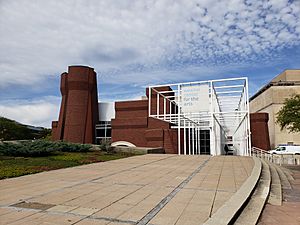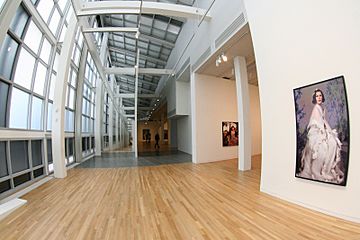Wexner Center for the Arts facts for kids
 |
|
 |
|
| Location | 1871 North High Street, Columbus, Ohio |
|---|---|
| Type | Contemporary art |
| Owner | Ohio State University |
| Public transit access | |
The Wexner Center for the Arts is a special place at Ohio State University. It's like a "laboratory" where artists can explore and create new contemporary art. Contemporary art means art made in our time.
The Wexner Center is a place for showing art and trying new things, but it's not a museum that collects lots of art. However, it does look after about 3,000 artworks that belonged to an older university gallery. These artworks help with the center's programs in visual art, media, and performing arts. Students and scholars at Ohio State University can study here, and it's also open to everyone else! The Wexner Center opened in November 1989. It was named after the father of Leslie Wexner, who gave a lot of money to help build it.
Contents
History of the Center
Before the Wexner Center, there was a gallery at the university called the University Gallery of Fine Art. In the 1970s, this gallery started showing works by important modern artists. It also began collecting art that later became part of the Wexner Center's collection. In the 1980s, Jonathan Green became the director and brought in art that focused on important social issues. The last show at the old gallery was in 1989, just before the Wexner Center opened.
The Wexner Center cost $43 million to build. Leslie H. Wexner, who went to Ohio State, promised $25 million for the project. Architect Peter Eisenman won a competition in 1983 to design the building. He was chosen over other famous architects. The building was so interesting that a magazine wrote a whole issue about it before it was even finished!
The Wexner Center officially opened on November 17, 1989. Many famous architects came to Columbus to celebrate. The New York Times newspaper called it "one of the most eagerly awaited architectural events of the last decade."
Between 2002 and 2005, the Wexner Center closed for a big renovation. During this time, its art shows moved to a different building. But the shows for performing arts and films stayed at the center. Before the renovation, about 200,000 to 250,000 people visited each year. The Wexner Center reopened in November 2005.
Amazing Architecture
The Wexner Center is a three-story building, about 108,000 square feet in size. It was designed by architects Peter Eisenman and Richard Trott, along with landscape architect Laurie Olin. This was the first big public building Eisenman designed. He believed that art should be "challenged" by its surroundings, not just shown in a plain way. This idea made his design very unique.
When planning the building, Eisenman and Trott chose a specific spot between two other university buildings. The design includes a large, white metal grid that looks a bit like scaffolding. This makes the building seem like it's always being built or is never quite finished. This idea is part of a style called deconstructivism.
The architects also noticed that the streets of the Ohio State campus and the city of Columbus don't line up perfectly. They are off by about 12 degrees. So, Eisenman designed the Wexner Center to follow both street grids in different parts of the building. This made the building very interesting to look at, even if some parts were a bit unusual to use. The brick towers on the building look like the old Ohio State University Armory, a castle-like building that used to be on the same spot.
Inside the Wexner Center, you'll find a film and video theater and a performance space called the Mershon Center stage. This stage can hold 2,500 people for dance, music, theater, and talks. There's also a studio for making films and videos, a bookstore, a café, and 12,000 square feet of art galleries. The galleries are set up in a line to make you feel like you're moving through a story. The Fine Arts Library is on the lower level. The architects used special lighting to make up for the lack of natural light, and a gray color scheme to help the art stand out.
In 1993, artist Maya Lin created a large art piece for the Wexner Center called Groundswell. It uses shattered glass to create interesting shapes in three areas of the building. That same year, the building won a big award for its design.
The renovation in 2005 improved the building's heating, cooling, lighting, and other systems. These changes were made carefully to keep the original design while making the building better for the environment and for controlling the climate inside. The bookstore, film theater, and café were also updated.
What You Can Do There
Art Exhibitions

The Wexner Center has shown many amazing art exhibitions. Some famous artists whose work has been displayed include Chris Marker, Julie Taymor, Shirin Neshat, Louise Lawler, William Wegman, and Andy Warhol.
In 2002, the Wexner had a huge show called Mood River. It featured industrial and commercial designs, including art by Simparch and Tony Cragg. In 2017, there was an exhibition by Cindy Sherman. In 2018, the center showed works by 16 artists who create modern abstract art, like Eric N. Mack and Sam Gilliam. In 2019, to celebrate its 30th anniversary, the Wexner Center started the year with a show called "HERE: Ann Hamilton, Jenny Holzer, Maya Lin."
The Box is a special area at the Wexner Center just for video and short film art. It opened in September 2005 and usually shows a new piece every month. Since 2022, it's free for everyone to visit the Wexner Center's art galleries!
Film and Video Theater
The Wexner Center's Film/Video department is known for showing unique films. They screen new and different movies, rare classics, and experimental films that you might not see anywhere else. They have a film program all year long that includes independent films, international movies, new documentaries, and more. Often, the filmmakers themselves visit to talk about their work with the audience.
The Film/Video department shows over 180 films and videos each year in their theater, which seats about 300 people. They also host filmmakers who come to visit. The Film/Video Studio Program helps filmmakers and video artists by giving them support for making and editing their projects. The department also runs The Box, the video exhibition space, and organizes art shows that include moving images. In 2002, this department won an award for being an "Outstanding Organization."
Performing Arts
The Wexner Center supports artists who create dance, music, and theater. They help artists develop new works and bring them to the stage. Some of the many talented artists and groups who have worked with the Wexner Center include Bill T. Jones, Anne Bogart and the SITI Company, Bebe Miller, Akram Khan, Elizabeth Streb, The Wooster Group, Savion Glover, Mark Morris, and the Kronos Quartet.
Awards for Artists
The Wexner Prize
The Wexner Prize started in 1992. It's given to an artist whose work is very new and creative, and shows high artistic quality. The winner receives $50,000 and a special sculpture designed by Jim Dine. The Wexner Center also holds events to explore the prize winner's career and ideas.
Past winners include film director Peter Brook (1992), choreographer Merce Cunningham (1993), artist Bruce Nauman (1994), filmmaker Martin Scorsese (1996/97), painter Gerhard Richter (1998), sculptor Louise Bourgeois (1999), architect Renzo Piano (2001), choreographer William Forsythe (2002), designer Issey Miyake (2004), and filmmaker Spike Lee (2008).
Artist Residencies
The Wexner Center also offers "residencies" to artists. This means they support artists while they work on new projects. These residencies often let artists interact with students at Ohio State and the public. This is a key part of the Wexner Center's goal to be a creative "research lab" for all kinds of art.
The Wexner Center Residency Awards are the biggest and most important residencies. They are given out every year in performing arts, media arts (film/video), and visual arts. Some projects can even last for two or more years.
Other artists who come for exhibitions and performances might also get support to create new works. They often do workshops, master classes, and talks with students or the community while they are at the center. Also, about 20 visiting filmmakers and video artists from all over the world are invited each year to work in the Film/Video Studio Program.
Some of the artists who have received Wexner Center Residency Awards include:
Performing arts:
- Young Jean Lee's Theater Company
- The Builders Association
- Twyla Tharp
- Elizabeth Streb
- Mark Morris Dance Group
- The Wooster Group
- Anne Bogart
- Bill T. Jones
- William Forsythe
Visual arts:
- Kerry James Marshall
- Zoe Leonard
- Josiah McElheny
- Maya Lin
- Ann Hamilton
- Barbara Kruger
- Lorna Simpson
- Shirin Neshat
- Lee Mingwei
- Hussein Chalayan
Media arts:
- Guy Maddin
- Jennifer Reeder
- Yvonne Rainer
- Jennifer Reeves
- Deborah Stratman
- Phil Collins
- Todd Haynes
- Julie Dash
- Isaac Julien
- Miranda July
- William Wegman
- Chris Marker
In Movies
Parts of the movie Little Man Tate, directed by Jodie Foster, were filmed at the Wexner Center in 1991.
Working Together
On March 4, 2022, the staff at the Wexner Center for the Arts announced they wanted to form a union. A union is a group that helps workers have a stronger voice. They called themselves Wex Workers United. The staff said they wanted better pay and a better working environment. On March 22, 2023, the union was officially approved by a vote.
How the Center is Run
As of 2021, the Wexner Center had about 70 staff members. In August 2021, it was announced that Johanna Burton, who was a director, would be leaving the Wexner Center in November 2021 to work at another museum. Since 2022, Gaëtane Verna has been the director.
See also
 In Spanish: Centro Wexner para las Artes para niños
In Spanish: Centro Wexner para las Artes para niños


